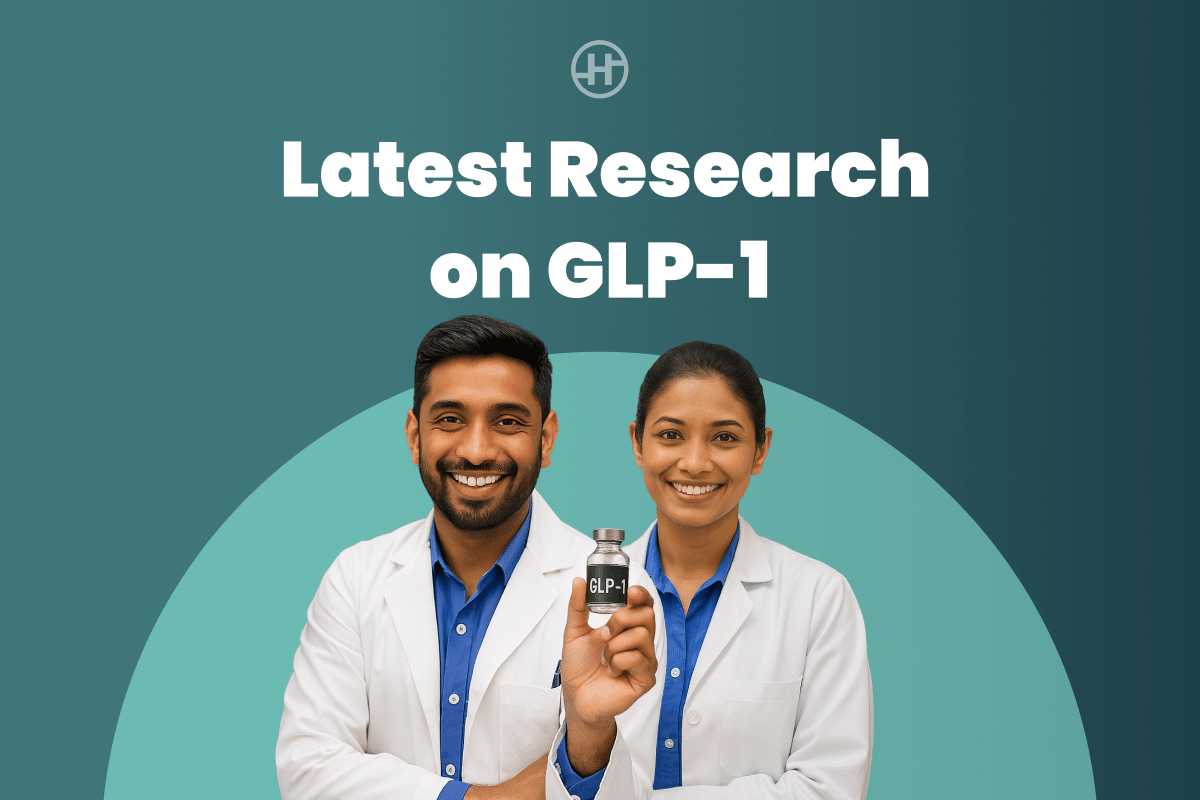Latest Research On GLP-1 And Its Future In Healthcare

Until recently, glucagon-like peptide-1 (GLP-1) receptor agonists were known primarily as a treatment for type 2 diabetes. But today, these drugs have transformed into a major player in weight loss therapy. Moreover, they are on the verge of reshaping the entire healthcare landscape. From treating obesity to possibly impacting neurodegenerative diseases and addiction disorders, the latest research on GLP-1 drugs offers insights that extend far beyond blood sugar control.
As the popularity of GLP-1 medications continues to rise, so does scientific curiosity around their broader potential. With new clinical trials, global regulatory approvals, and increasing investment from the pharmaceutical industry, we are now witnessing an era where GLP-1 medications are being considered not just for managing chronic diseases but for preventing them. This article explores the most promising trends in GLP-1 research and what it means for the future of medicine.
The field is bustling with activity, from increased insurance coverage debates to oral GLP-1 medications, from exploring cardiovascular and kidney benefits to studying their effects on brain health. The future of GLP-1 in healthcare is no longer limited to metabolic diseases. It is now about building a foundation for comprehensive, preventive, and long-term healthcare.
What is GLP-1 and How Does it Work?
GLP-1, or glucagon-like peptide-1, is a hormone produced in the intestines in response to food. It helps regulate blood sugar levels by enhancing insulin secretion, suppressing glucagon, and slowing gastric emptying. When you eat, GLP-1 sends satiety signals to your brain, helping you feel full faster and longer. These combined actions make it an ideal target for treating conditions like type 2 diabetes and obesity.
GLP-1 receptor agonists are synthetic versions of this hormone. They mimic GLP-1 to regulate blood sugar, reduce appetite, and facilitate weight loss. Some newer agents, such as tirzepatide, also act on another hormone called GIP (glucose-dependent insulinotropic polypeptide), which offers even broader metabolic effects.
Initially introduced in 2005 for diabetes treatment, GLP-1 drugs quickly gained traction in weight loss management by 2014. They are currently available as injections (weekly or daily) and, more recently, as oral tablets like Rybelsus.
Current Usage: Where GLP-1 Stands Today
GLP-1 receptor agonists such as Ozempic, Wegovy, Mounjaro, Saxenda, and Rybelsus are now commonly prescribed for type 2 diabetes and obesity. Clinical trials have shown that these medications can lead to weight loss ranging from 10% to 22% of initial body weight when used with dietary changes and exercise.
Wegovy (semaglutide) and Zepbound (tirzepatide) are specifically FDA-approved for weight loss. At the same time, others like Ozempic and Mounjaro are prescribed for diabetes but are often used off-label for weight loss. These medications have also shown cardiovascular benefits, such as reducing the risk of heart attacks and strokes.
The Latest Research on GLP-1: What Studies Reveal
The past few years have witnessed a surge in high-quality research into GLP-1 receptor agonists.
Recent studies have significantly expanded our understanding of GLP-1 receptor agonists and their effects beyond weight loss and diabetes control. A groundbreaking atlas published in Nature Medicine studied over 2.4 million individuals and mapped 175 health outcomes associated with GLP-1 RA use.
The findings suggest that GLP-1 drugs may reduce risks associated with a wide array of conditions, ranging from respiratory infections and cardiovascular events to substance use and neurodegenerative disorders such as dementia and Alzheimer’s disease.
Research also compared GLP-1 medications with other diabetes treatments and found remarkable results:
- Reduced risk of 42 health conditions, including cardiovascular events, liver failure, and substance use disorders.
- Increased risk of only 19 outcomes, primarily related to gastrointestinal side effects such as nausea, vomiting, and gastroparesis.
- Reduced risk of neurodegenerative diseases like Alzheimer’s and dementia by up to 30%.
Another key study examined GLP-1 medications’ impact on alcohol consumption. Users of semaglutide and tirzepatide reported significantly reduced cravings and alcohol intake. There is now growing interest in exploring GLP-1s as treatments for addiction disorders.
Clinical trials have also revealed GLP-1’s role in cardiovascular protection. A 2023 trial found that Wegovy reduced the risk of heart attack and stroke by 20% in overweight adults with heart disease, even without diabetes.
More from Recent Studies
Additional research shows promising outcomes in mental health and addiction control. A 2023 study revealed that patients on semaglutide or tirzepatide reported reduced cravings for alcohol and fewer binge episodes. Early trials even hint at the drugs’ potential in easing symptoms of Parkinson’s disease, and target trial emulations show lower risks of psychotic disorders and suicidality.
What the Future Holds: Five Trends Defining GLP-1’s Evolution
As we step into the next phase of GLP-1’s medical journey, several trends are redefining its place in modern healthcare. These developments offer both hope and new avenues for treatment, extending far beyond diabetes and weight loss.
1. Expanded Medical Applications
GLP-1 medications are being studied for new indications, including chronic kidney disease, heart failure with preserved ejection fraction (HFpEF), and liver inflammation due to metabolic dysfunction-associated steatohepatitis (MASH). Their role in reducing the risks of cardiovascular events and kidney disease could bring widespread clinical application across metabolic disorders.
- Chronic Kidney Disease (CKD): Ozempic is under FDA review for use in CKD patients.
- Heart Failure with Preserved Ejection Fraction (HFpEF): Both tirzepatide and semaglutide show promise.
- Metabolic dysfunction-associated steatohepatitis (MASH): Trials have demonstrated reductions in liver inflammation.
- Neurodegenerative Diseases: Early evidence shows protective effects against dementia and Parkinson’s.
- Substance Use Disorders: Ongoing trials are evaluating its efficacy in reducing addiction behaviors.
2. New Injectables and Combination Therapies
Among the most awaited innovations is CagriSema, a combination of semaglutide and cagrilintide (an amylin analog). In early trials, it showed up to 23% weight loss, outperforming even Wegovy.
Other injectables in the pipeline include:
- Retatrutide
- Survodutide
- VK2735
These drugs aim to improve efficacy while minimizing side effects.
3. Oral Options and GLP-1 Drops
Currently, Rybelsus is the only oral GLP-1 option. Higher doses (25mg and 50mg) are being tested and may receive FDA approval in 2025.
Orforglipron, a non-peptide GLP-1 drug, is also being studied. Its chemical composition may reduce manufacturing costs and eliminate the need for refrigeration.
There is also increasing curiosity about GLP-1 drops, though most of these are still in experimental stages.
4. The Rise of GLP-1 Generics and Insurance Shifts
Generic versions of Victoza and Byetta have been launched. However, due to patent protections, generics for newer drugs like Ozempic or Wegovy are not expected before 2030.
Insurance companies are reevaluating coverage:
- Some are expanding coverage for CKD and cardiovascular conditions.
- Others are scaling back coverage solely for weight loss due to high costs.
- Medicare and Medicaid may expand access, pending policy changes.
5. Adherence and Accessibility
Adherence to GLP-1 medication remains a challenge. Studies show that nearly half of users stop within a year, citing side effects, cost, and insurance limitations. There are concerns about fake medications due to rising demand and drug shortages. Proper medical supervision remains essential.
6. Rise in Use Among Younger Populations
A 594% increase in the use of GLP-1 drugs among adolescents and young adults (ages 12–25) has raised both hope and concern. While it signals increased accessibility, it also calls for caution in terms of long-term safety, hormonal development, and mental health impact.
7. Ongoing Research on Side Effects and Personalized Outcomes
New findings continue to explore rare but serious side effects such as gastroparesis, pancreatitis, and mood disturbances. Studies are also investigating genetic factors that affect individual responses to GLP-1 drugs, aiming to make future treatment more personalized and safe.
What is the Best GLP-1 on the Market?
There is no single best GLP-1 drug, but clinical trial data give us some clues:
- Tirzepatide (Zepbound/Mounjaro) consistently shows the most significant weight loss.
- Semaglutide (Wegovy/Ozempic) has been studied more for cardiovascular health.
- Liraglutide (Saxenda) remains a reliable option, especially for daily users.
What works best may depend on personal health conditions, genetics, cost, and whether a user prefers weekly injections or daily tablets. To determine the most effective combination, more head-to-head comparisons, like CagriSema vs. tripeptide, are underway.
Can GLP-1 Alone Deliver Long-Term Weight Loss?
GLP-1 receptor agonists are undeniably effective for weight reduction, but emerging research and real-world experience indicate that they are not a standalone solution. Discontinuation often leads to weight regain, as observed in trials like SURMOUNT-4, where participants regained much of their lost weight within a year of stopping tirzepatide. This pattern highlights the physiological complexity of obesity and the body’s tendency to revert to a higher weight set point.
Long-term use of GLP-1 drugs may be required for sustained benefits, but that raises concerns about affordability, side effects, and adherence. More importantly, weight loss achieved through medication alone lacks the behavioral changes that reinforce healthier habits. For comprehensive results, GLP-1 therapy should be coupled with structured lifestyle interventions like dietary coaching, physical activity, and mental wellness support. This integrated approach supports sustainable weight management and also enhances overall metabolic health.
HealthifyMe Note
As a HealthifyMe coach, I often see the excitement and curiosity surrounding GLP-1 medications. And rightly so; these drugs are rewriting the rules of weight loss. But in the quest for transformation, it is easy to forget that health is not a number on a scale or a dose in a pen. GLP-1 drugs can guide the journey, but only mindful eating, regular activity, and a deep understanding of one’s own body can create lasting change.
That is where the GLP-1 + Healthify Coach program steps in. We offer not just prescription support but continuous education, emotional accountability, side effect management and nutritional and fitness insights tailored to your body. True health is not built on shortcuts; it is built on sustained effort and smart support. Our mission is to help you own your story, your weight, and your wellness. And we do it together.
The Final Word
The latest research on GLP-1 is a window into the future of personalized medicine. From managing chronic diseases to unlocking new frontiers in neurology and addiction, GLP-1 drugs are changing the way we think about long-term care. But this power comes with responsibility. Proper usage under medical guidance is non-negotiable.
This growing interest in GLP-1s is more than a trend; it is a shift in medical thinking. The rise of oral options, combination drugs, and tailored therapies show that this field is just getting started. As we learn more, we can expect safer, smarter, and more targeted solutions.
HealthifyMe believes in combining the strength of science with the power of coaching. Our GLP-1 + Healthify Coach program is built on this vision. It is not just about medication. It is about education, awareness, and real-life personalised support. When GLP-1s meet the right strategy, transformation is inevitable.
Frequently Asked Questions (FAQs)
Q: What is the latest research on GLP-1 drugs?
A: Recent studies, including one published in Nature Medicine, show that GLP-1 receptor agonists may reduce the risk of over 40 health conditions. These include heart disease, dementia, and substance use disorders. The same studies also caution against gastrointestinal risks and emphasize the need for long-term use.
Q: What is the future of GLP-1 in healthcare?
A: The future includes expanded indications beyond diabetes and obesity. Trials are ongoing for CKD, liver inflammation (MASH), heart failure, and even Parkinson’s. Oral options and generics are also set to make these medications more accessible.
Q: Are GLP-1 drugs safe for everyone?
A: While generally safe, they are not suitable for pregnant women, individuals with thyroid issues, or those with a history of pancreatitis. Always consult a healthcare provider before starting.
Q: Which GLP-1 drug is considered the best right now?
A: Tirzepatide (Zepbound) is the most effective weight loss drug. Semaglutide (Wegovy) has more cardiovascular research backing it. The best option depends on your health goals and your doctor’s advice.
Q: Can I get GLP-1 medication without a prescription?
A: No. These drugs require a medical prescription. Products marketed as GLP-1 drops or over-the-counter alternatives are not FDA-approved and may be unsafe.
Q: Do GLP-1 medications help with other conditions?
A: Yes. Research shows potential in treating addiction, neurodegenerative diseases, and even reducing the risk of some cancers. However, these uses are still under investigation.
Q: What are the common side effects of GLP-1 medications?
A: Common side effects include nausea, bloating, diarrhea, and constipation. In rare cases, more serious effects like pancreatitis or kidney stones may occur. Ongoing monitoring is essential.
Q: Will I regain weight after stopping GLP-1 medications?
A: Many patients do regain weight after stopping. That is why combining GLP-1 treatment with lifestyle changes is key to long-term success.
Q: How long has GLP-1 been used in medicine?
A: GLP-1 receptor agonists have been used since 2005 for diabetes and since 2014 for weight loss. Their use has increased significantly in the last five years.
Q: How do GLP-1 inhibitors and analogues differ?
A: GLP-1 analogues mimic the natural hormone, while GLP-1 inhibitors (though less commonly used) aim to prevent its breakdown. Most drugs today use analogue or agonist mechanisms to improve efficacy.
Research Sources
3. Mapping the effectiveness and risks of GLP-1 receptor agonists
4. 2024 Best Practices in Healthcare Survey
6. 2025 Pharmacy in Focus Report
7. GLP-1 Receptor Agonist Discontinuation Among Patients With Obesity and/or Type 2 Diabetes
8. Advancements in FDA approvals for pediatric obesity treatment
9. Semaglutide in Comorbid Schizophrenia Spectrum Disorder and Obesity (Sema)
10. Hot weight loss drugs tested as addiction treatments
11. Amylin and Lilly Announce FDA Approval of BYETTA(TM) (Exenatide) Injection
12. Novo Nordisk receives FDA approval for Saxenda® for the treatment of obesity
14. Continued Treatment With Tirzepatide for Maintenance of Weight Reduction in Adults With Obesity




